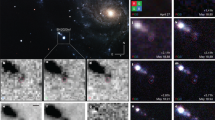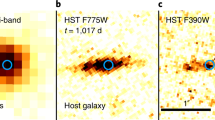Abstract
Very massive stars shed much of their mass in violent precursor eruptions1 as luminous blue variables2 (LBVs) before reaching their most likely end as supernovae, but the cause of LBV eruptions is unknown. The nineteenth-century eruption of η Carinae, the prototype of these events3, ejected about 12 solar masses at speeds of 650 km s-1, with a kinetic energy of almost 1050 erg (ref. 4). Some faster material with speeds up to 1,000–2,000 km s-1 had previously been reported5,6,7,8 but its full distribution was unknown. Here I report observations of much faster material with speeds up to 3,500–6,000 km s-1, reaching farther from the star than the fastest material in previous reports5. This fast material roughly doubles the kinetic energy of the nineteenth-century event and suggests that it released a blast wave now propagating ahead of the massive ejecta. As a result, η Carinae’s outer shell now mimics a low-energy supernova remnant. The eruption has usually been discussed in terms of an extreme wind driven by the star’s luminosity2,3,9,10, but the fast material reported here indicates that it may have been powered by a deep-seated explosion rivalling a supernova, perhaps triggered by the pulsational pair instability11. This may alter interpretations of similar events seen in other galaxies.
This is a preview of subscription content, access via your institution
Access options
Subscribe to this journal
Receive 51 print issues and online access
$199.00 per year
only $3.90 per issue
Buy this article
- Purchase on Springer Link
- Instant access to full article PDF
Prices may be subject to local taxes which are calculated during checkout



Similar content being viewed by others
References
Smith, N. & Owocki, S. P. On the role of continuum-driven eruptions in the evolution of very massive stars and Population III stars. Astrophys. J. 645, L45–L48 (2006)
Humphreys, R. M. & Davidson, K. The luminous blue variables: Astrophysical geysers. Publ. Astron. Soc. Pacif. 106, 1025–1051 (1994)
Davidson, K. & Humphreys, R. M. Eta Carinae and its environment. Annu. Rev. Astron. Astrophys. 35, 1–32 (1997)
Smith, N. et al. Mass and kinetic energy of the Homunculus nebula around η Carinae. Astron. J. 125, 1458–1466 (2003)
Smith, N. & Morse, J. A. Nitrogen and oxygen abundance variations in the outer ejecta of η Carinae: Evidence for recent chemical enrichment. Astrophys. J. 605, 854–863 (2004)
Smith, N. Dissecting the Homunculus nebula around Eta Carinae with spatially resolved near-infrared spectroscopy. Mon. Not. R. Astron. Soc. 337, 1252–1268 (2002)
Davidson, K., Smith, N., Gull, T. R., Ishibashi, K. & Hillier, D. J. The shape and orientation of the Homunculus nebula based on spectroscopic velocities. Astron. J. 121, 1569–1577 (2001)
Currie, D. G., Dorland, B. N. & Kaufer, A. Discovery of a high velocity, spatially extended emission ‘shell’ in front of the southeast lobe of the η Carinae Homunculus. Astron. Astrophys. 389, L65–L68 (2002)
Owocki, S. P., Gayley, K. G. & Shaviv, N. J. A porosity-length formalism for photon-tiring-limited mass loss from stars above the Eddington limit. Astrophys. J. 616, 525–541 (2004)
Shaviv, N. J. The porous atmosphere of η Carinae. Astrophys. J. 532, L137–L140 (2000)
Heger, A. & Woosley, S. F. The nucleosynthetic signature of Population III. Astrophys. J. 567, 532–543 (2002)
Damineli, A., Conti, P. S. & Lopes, D. F. Eta Carinae: A long-period binary? N. Astron. 2, 107–117 (1997)
Morse, J. A. et al. Hubble Space Telescope proper-motion measurements of the η Carinae nebula. Astrophys. J. 548, L207–L211 (2001)
Smith, N. The structure of the Homunculus. I. Shape and latitude dependence from H2 and [Fe II] velocity maps of η Carinae. Astrophys. J. 644, 1151–1163 (2006)
Smith, N., Davidson, K., Gull, T. R., Ishibashi, K. & Hillier, D. J. Latitude-dependent effects in the stellar wind of η Carinae. Astrophys. J. 586, 432–450 (2003)
Walborn, N. R. The complex outer shell of Eta Carinae. Astrophys. J. 204, L17–L19 (1976)
Walborn, N. R., Blanco, B. M. & Thackeray, A. D. Proper motions in the outer shell of Eta Carinae. Astrophys. J. 219, 498–503 (1978)
Meaburn, J., Wolstencroft, R. D. & Walsh, J. R. Echelle and spectropolarimetric observations of the Eta Carinae nebulosity. Astron. Astrophys. 181, 333–342 (1987)
Weis, K., Duschl, W. J. & Bomans, D. J. High velocity structures in, and the X-ray emission from the LBV nebula around η Carinae. Astron. Astrophys. 367, 566–576 (2001)
Davidson, K., Dufour, R. J., Walborn, N. R. & Gull, T. R. Ultraviolet and visual wavelength spectroscopy of gas around Eta Carinae. Astrophys. J. 305, 867–879 (1986)
Smith, N., Brooks, K. J., Koribalski, B. & Bally, J. Cleaning up η Carinae: Detection of ammonia in the Homunculus nebula. Astrophys. J. 645, L41–L44 (2006)
Pittard, J. M. & Corcoran, M. F. In hot pursuit of the hidden companion of η Carinae: An X-ray determination of the wind parameters. Astron. Astrophys. 383, 636–647 (2002)
Seward, F. D. et al. Early Chandra X-ray observations of η Carinae. Astrophys. J. 553, 832–836 (2001)
Woosley, S. F., Blinnikov, S. & Heger, A. Pulsational pair instability as an explanation for the most luminous supernovae. Nature 450, 390–392 (2007)
Smith, N. et al. SN 2006gy: Discovery of the most luminous supernova ever recorded, powered by the death of an extremely massive star like η Carinae. Astrophys. J. 666, 1116–1128 (2007)
Foley, R. J. et al. 2006jc: A Wolf–Rayet star exploding in a dense He-rich circumstellar medium. Astrophys. J. 657, L105–L108 (2007)
Pastorello, A. et al. A giant outburst two years before the core-collapse of a massive star. Nature 447, 829–832 (2007)
Van Dyk, S. D. et al. SN 1997bs in M66: Another extragalactic η Carinae analog? Publ. Astron. Soc. Pacif. 112, 1532–1541 (2000)
Goodrich, R. W., Stringfellow, G. S., Penrod, G. D. & Filippenko, A. V. S. N. 1961V: An extragalactic Eta Carinae analog? Astrophys. J. 342, 908–916 (1989)
Acknowledgements
I acknowledge continuing collaboration and relevant discussions with the supernova group at the University of California at Berkeley.
Author information
Authors and Affiliations
Corresponding author
Supplementary information
Supplementary Figures
This file contains Supplementary Figures 1 - 2 with legends (PDF 4952 kb)
Rights and permissions
About this article
Cite this article
Smith, N. A blast wave from the 1843 eruption of η Carinae. Nature 455, 201–203 (2008). https://doi.org/10.1038/nature07269
Received:
Accepted:
Issue Date:
DOI: https://doi.org/10.1038/nature07269
This article is cited by
-
A UV resonance line echo from a shell around a hydrogen-poor superluminous supernova
Nature Astronomy (2018)
-
Light echoes cause rethink of supernova imposter
Nature (2012)
-
Light echoes reveal an unexpectedly cool η Carinae during its nineteenth-century Great Eruption
Nature (2012)
-
Rest et al. reply
Nature (2012)
Comments
By submitting a comment you agree to abide by our Terms and Community Guidelines. If you find something abusive or that does not comply with our terms or guidelines please flag it as inappropriate.



